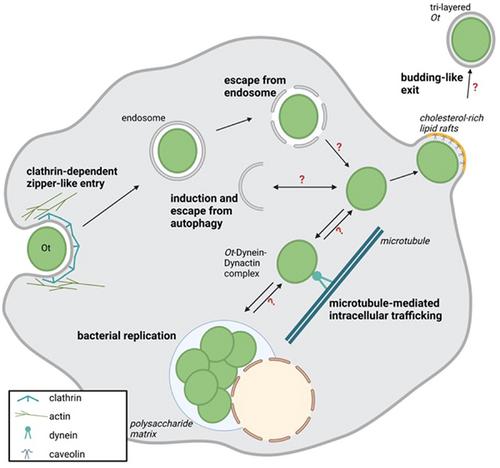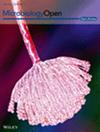恙虫病东方体:逃亡之间的生活
IF 4.6
3区 生物学
Q2 MICROBIOLOGY
引用次数: 0
摘要
由螨传播的专性细胞内病原体恙虫病东方体(Ot)是人类恙虫病的病原体,其生命周期在许多方面与立克次体目其他成员不同。特别是,个别Ot细菌在质膜上的非溶解性细胞退出与包膜病毒的出芽非常相似,但仅在分子水平上进行了初步研究。这篇简短的文章重点介绍了Ot生命周期中逃逸事件的知识现状,并强调了其他立克次体在策略上的差异。本文章由计算机程序翻译,如有差异,请以英文原文为准。

Orientia tsutsugamushi: A life between escapes
The life cycle of the mite-borne, obligate intracellular pathogen Orientia tsutsugamushi (Ot), the causative agent of human scrub typhus, differs in many aspects from that of other members of the Rickettsiales order. Particularly, the nonlytic cellular exit of individual Ot bacteria at the plasma membrane closely resembles the budding of enveloped viruses but has only been rudimentarily studied at the molecular level. This brief article is focused on the current state of knowledge of escape events in the life cycle of Ot and highlights differences in strategies of other rickettsiae.
求助全文
通过发布文献求助,成功后即可免费获取论文全文。
去求助
来源期刊

MicrobiologyOpen
MICROBIOLOGY-
CiteScore
8.00
自引率
0.00%
发文量
78
审稿时长
20 weeks
期刊介绍:
MicrobiologyOpen is a peer reviewed, fully open access, broad-scope, and interdisciplinary journal delivering rapid decisions and fast publication of microbial science, a field which is undergoing a profound and exciting evolution in this post-genomic era.
The journal aims to serve the research community by providing a vehicle for authors wishing to publish quality research in both fundamental and applied microbiology. Our goal is to publish articles that stimulate discussion and debate, as well as add to our knowledge base and further the understanding of microbial interactions and microbial processes.
MicrobiologyOpen gives prompt and equal consideration to articles reporting theoretical, experimental, applied, and descriptive work in all aspects of bacteriology, virology, mycology and protistology, including, but not limited to:
- agriculture
- antimicrobial resistance
- astrobiology
- biochemistry
- biotechnology
- cell and molecular biology
- clinical microbiology
- computational, systems, and synthetic microbiology
- environmental science
- evolutionary biology, ecology, and systematics
- food science and technology
- genetics and genomics
- geobiology and earth science
- host-microbe interactions
- infectious diseases
- natural products discovery
- pharmaceutical and medicinal chemistry
- physiology
- plant pathology
- veterinary microbiology
We will consider submissions across unicellular and cell-cluster organisms: prokaryotes (bacteria, archaea) and eukaryotes (fungi, protists, microalgae, lichens), as well as viruses and prions infecting or interacting with microorganisms, plants and animals, including genetic, biochemical, biophysical, bioinformatic and structural analyses.
The journal features Original Articles (including full Research articles, Method articles, and Short Communications), Commentaries, Reviews, and Editorials. Original papers must report well-conducted research with conclusions supported by the data presented in the article. We also support confirmatory research and aim to work with authors to meet reviewer expectations.
MicrobiologyOpen publishes articles submitted directly to the journal and those referred from other Wiley journals.
 求助内容:
求助内容: 应助结果提醒方式:
应助结果提醒方式:


